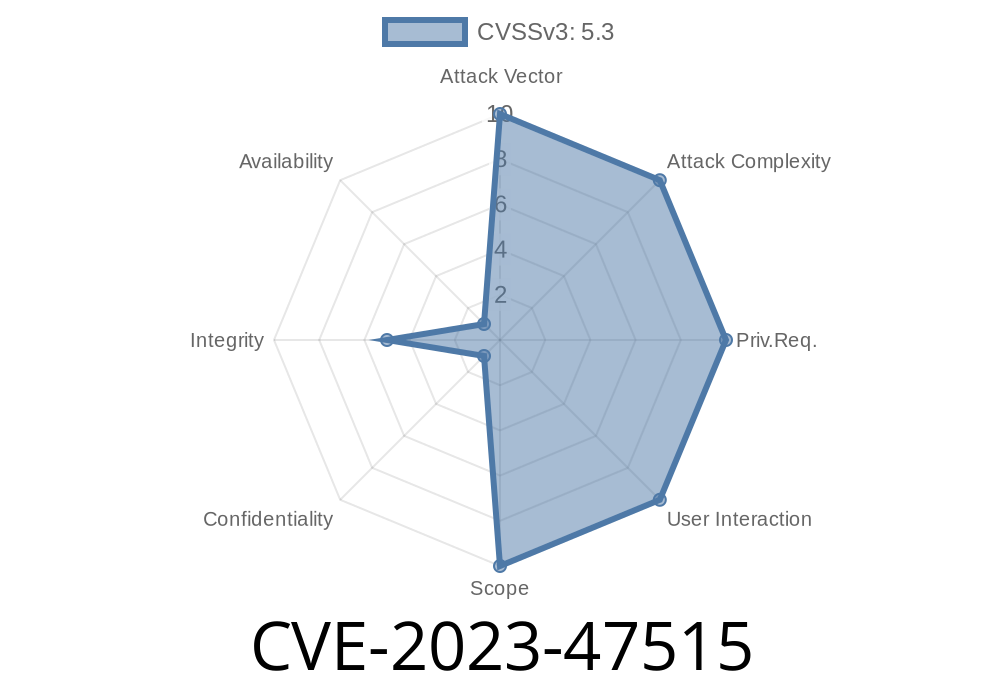In November 2023, security researchers discovered a serious vulnerability tracked as CVE-2023-47515 in the Seers platform. Seers is widely used for privacy and consent management by businesses across the globe, especially for GDPR and CCPA compliance. This issue allows an attacker to exploit missing authorization controls and incorrectly configured security settings, potentially leading to unauthorized access to sensitive functions and data.
This exclusive post will break down what CVE-2023-47515 is, show code-level details, explain the risks, and demonstrate how an attacker might exploit this flaw. If you’re running a Seers version before 8.1.1, read on to understand how to protect your systems.
What is CVE-2023-47515?
According to NIST’s official entry and Seers security advisory, the flaw is a missing authorization vulnerability. This means Seers fails to check if a user is allowed to access certain functions or resources, letting anyone bypass normal security controls.
Affected Versions:
All Seers versions from inception up to 8.1.1 are vulnerable.
The Problem: Broken Access Control
In many web applications, certain actions should only be accessible to logged-in administrators or users with proper roles. For example, viewing or modifying privacy settings should not be possible for anonymous visitors or normal users.
Seers modules, however, had an endpoint (e.g., /api/v1/admin/settings/update) that could be accessed without proper authorization checks. This means that even if you're not an admin, you can potentially hit these endpoints and change settings.
Let’s say, in Node.js/Express, the route in question looks something like this
// Example: Missing authorization middleware
app.post('/api/v1/admin/settings/update', async (req, res) => {
const { settings } = req.body;
await Settings.update(settings); // Danger!
res.json({ message: 'Settings updated' });
});
Notice there’s no authorization middleware like checkAdmin() to verify who is making the request. This is the core issue.
A secure implementation SHOULD look like this
// Proper authorization check!
app.post('/api/v1/admin/settings/update', checkAdmin, async (req, res) => {
const { settings } = req.body;
await Settings.update(settings);
res.json({ message: 'Settings updated' });
});
An attacker might discover the existence of admin endpoints using
- Web application scanning (tools like OWASP ZAP)
2. Sending a Malicious Request
Once the endpoint is found, the attacker can simply send requests to it without authentication tokens.
Example Exploit with curl
curl -X POST https://yourdomain.com/api/v1/admin/settings/update \
-H "Content-Type: application/json" \
-d '{"settings": {"consent_banner_text": "Hacked by attacker", "cookie_policy_link": "http://evil.com"}}';
If the endpoint is vulnerable, this request will go through, and crucial privacy or policy settings may be changed, seen by all users.
3. Real-World Impact
- Privacy Banner Defacement: Attackers can change messages in privacy banners and links, causing user confusion or phishing (redirect to malicious sites).
- Disabling Privacy Controls: They can disable cookie banners or change GDPR enforcement, making the business non-compliant.
References
- CVE-2023-47515 (NIST)
- Seers Security Advisory
- OWASP Broken Access Control
Verify Access Control
Double-check your routes and endpoints. Every sensitive API should check the user's role and authentication.
Sample Protection Middleware
function checkAdmin(req, res, next) {
if (!req.user || req.user.role !== 'admin') {
return res.status(403).json({ message: 'Forbidden' });
}
next();
}
Conclusion
CVE-2023-47515 is a classic yet dangerous web application security bug. If left unresolved, businesses risk not just technical damage but also regulatory penalties. Always enforce authorization checks on administrative and sensitive routes, and make sure to keep your software updated.
If you suspect exploitation or need more technical help, reach out to Seers support or your security team right away.
Timeline
Published on: 01/02/2025 12:15:15 UTC
